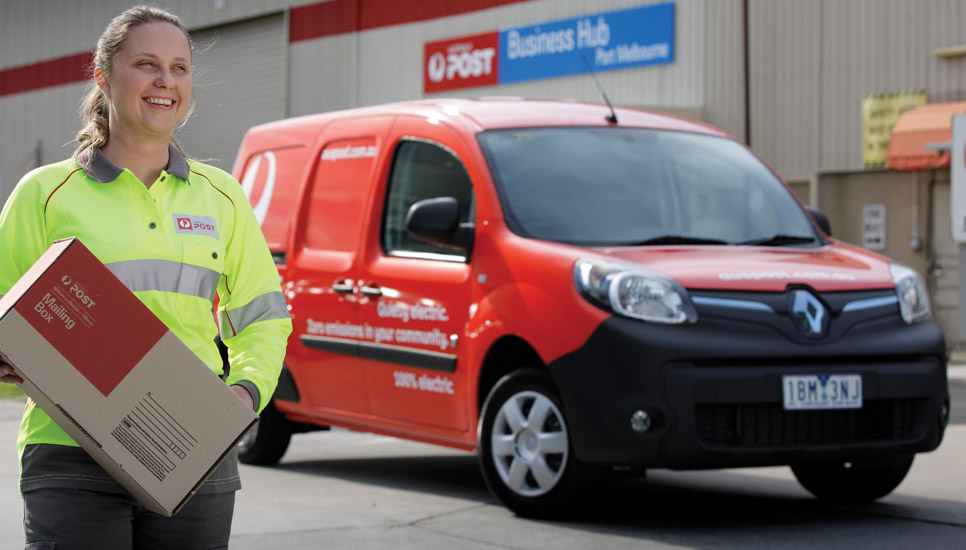Delivering better environmental outcomes to become a leader in environmental sustainability.
Highlights
- Reducing Scope 1 and 2 carbon emissions by a further 6.9 per cent
- Running a pilot to introduce Australia's first commercial electric van
Challenges
- Continually improving the way that we implement environmental initiatives across the enterprise
- Raising awareness of environmental considerations across our outsourced supply chain
Outlook
- Broadening engagement in environmental issues with our workforce and customers
- Growing product stewardship programs and building momentum towards a collaborative economy
Australia Post is dedicated to finding new ways to improve. This means minimising costs, better managing our resources and identifying avenues to create value for our customers, our workforce and for the environment.
This year we continued our focus on driving clean energy and energy efficiency programs across our 1,200 facilities, as well as becoming more fuel efficient by exploring alternative fuels for our fleet of 12,000 vehicles. We also worked with our customers to develop better environmental outcomes.
Our approach to environmental management supports our commitments under the United Nations Global Compact and aligns with the International Standard for Environmental Management, ISO14001. Our Environmental Management System enables us to identify and prioritise important environmental issues. It guides continual improvements in our environmental performance, which is monitored by the Australia Post Board Audit and Risk Committee. In 2013–14 we had no significant environmental incidents, spills, fines or prosecutions.
For more detailed environment data go to auspost.com.au/annualreport2014
Reducing our carbon emissions
In 2010 we established an ambitious target to reduce carbon emission levels by 25 per cent by 2020 (based on tonnes of carbon1 emission levels generated in 2000). Four years on, we continue to implement carbon reduction initiatives such as our National Energy Management Plan, energy audits, energy and fuel efficiency projects and our dedicated research and development (R&D) activities across our business.
In 2013–14 we reduced our Scope 1 and 2 carbon emissions by a further 6.9 per cent. We have now achieved a total 14 per cent improvement on our Scope 1 and 2 carbon emissions baseline, which keeps us on track to achieve our 2020 target.
This year we revised the original Scope 1 and 2 baseline to include StarTrack by including the StarTrack total of 50,601 tonnes of Scope 1 and 2 carbon emissions from our 2013 National Greenhouse and Energy Report (NGER).
The revised profile of our emissions appears below:
Over the past three years (2010–11 to 2013–14) we have achieved annual average savings of 15,330 tonnes of carbon.
This year we produced 299,557 tonnes of Scope 1 and 2 emissions (down 22,301 tonnes of carbon from last year), which, for the first time, included StarTrack's carbon emissions.
We achieved savings this year through a combination of meeting internal energy efficiency targets, property upgrades, changes to emission factors, and the benefits of transferring a major data centre to third-party management.
1 Tonnes of carbon dioxide equivalent (CO2e) – expressed as “tonnes of carbon”.
Greater fuel efficiency
We are constantly exploring ways to adopt alternative fuels across our transport fleet as part of our broader environmental strategy. Overall fuel consumption was down 3.9 per cent (more than 1.6 million litres) this year and we achieved a further 4,411-tonne reduction in carbon emissions due to new initiatives such as:
- using biofuel at selected facilities, (saving almost 1,000 tonnes of carbon each year)
- commissioning 1,871 new Honda NBC110s motorbikes that are 60 per cent more fuel-efficient
- transitioning from six-cylinder to four-cylinder sedans, with more than 100 hybrid vehicles
- using an extendable conveyor to “loose load” parcels directly into transport containers on selected line haul routes, improving container storage capacity
- partnering with Renault Australia to assess the use of Australia's first fully electric-powered commercial van – the Renault Kangoo Maxi Z.E. (see image below). We expect to halve energy costs and achieve a 100 per cent reduction in carbon emissions when compared to our existing vehicles.

Image: The Renault Kangoo Maxi Z.E.
Scope 1, 2 and 3 greenhouse gas emissions (tonnes CO2e) – by source
|
|
Emission source |
1999‑00 (baseline) |
2010‑11 |
2011‑12 |
2012‑13 |
2013‑14 |
|
Scope 1 Direct emissions |
Natural gas |
5,444 |
5,972 |
5,308 |
5,819 |
4,461 |
|
LPG |
3,019 |
5,266 |
5,820 |
5,796 |
5,962 |
|
|
Heating oil |
68 |
0 |
0 |
0 |
0 |
|
|
Diesel (including electricity generation) |
86,630 |
94,716 |
96,488 |
97,320 |
95,809 |
|
|
Petrol |
15,866 |
12,706 |
11,862 |
11,432 |
9,724 |
|
|
Total |
111,027 |
118,656 |
119,478 |
120,368 |
115,956 |
|
|
Scope 2 Indirect emissions |
Electricity |
237,409 |
226,892 |
212,044 |
201,490 |
183,601 |
|
Total |
237,409 |
226,892 |
212,044 |
201,490 |
183,601 |
|
|
|
Total Scope 1 and Scope 2 |
348,436 |
345,548 |
331,522 |
321,858 |
299,557 |
|
Scope 3 |
Energy Production and Transfer |
40,576 |
37,001 |
36,761 |
36,120 |
39,479 |
|
Subcontracted transport and business travel |
0 |
454,618 |
429,423 |
407,564 |
575,458 |
|
|
LPOs electrcity consumption (estimated) |
0 |
16,704 |
16,790 |
13,743 |
26,089 |
|
|
Waste disposal |
29,031 |
14,106 |
9,497 |
0 |
10,539 |
|
|
|
Total Scope 3 |
69,607 |
522,429 |
512,550 |
503,933 |
651,563 |
|
|
Total Scope 1, 2, and 3 emissions |
418,043 |
867,977 |
844,072 |
825,790 |
951,120 |
Note: All 2013–14 data includes StarTrack. Scope 1 and 2 emissions from baseline to 2012–13 include StarTrack 2013 NGER data.
Subcontracted transport and business travel provided for the 2013 calendar year. Majority of Scope 3 subcontracted transport carbon emissions are based on km travelled. Kilometres travelled are based on the type of vehicle and converted to carbon emissions using the National Greenhouse Accounts Factors – July 2013.
Greater energy efficiency
Energy use within our buildings and facilities accounts for approximately two-thirds of our carbon emissions, making it one of our largest environmental impacts.
This year energy efficiency improvements across our network of post offices, mail facilities and administrative offices achieved 3,704 MWh of energy savings and saved 3,397 tonnes of carbon. These initiatives included:
- 31 energy audits, resulting in the introduction of 17 initiatives. They also achieved approximately $240,000 and 1,321 MWh (1,129 tonnes of carbon) in savings
- dedicated projects at various Australia Post sites, including the installation of new SmartCool climate control systems across 97 post offices. This led to 288 MWh (251 tonnes of carbon) and $67,000 in energy savings
- a project at our Ballarat Business Centre which saw new lighting, insulation and rapid doors installed. This improved the site's energy efficiency by more than 30 per cent. Some initiatives were combined at this site to achieve a significant overall energy saving
- a program to replace heating, ventilation and air conditioning (HVAC) units and/or introduce speed roller doors at almost 100 facilities.
StarTrack House
In 2013–14 we achieved significant energy savings as part of a major refurbishment at StarTrack House (see Postal Services). The new initiatives included:
- new energy-efficient T5 light fittings that will reduce energy consumption and extend the life of lighting tubes, without compromising lighting levels
- more than 1,000 solar PV panels producing approximately 370 MWh of electricity per annum; enough to reduce carbon emissions by around 318 tonnes of carbon.
Managing waste
Waste reduction program
We have a number of waste management strategies in place to assess and reduce waste. In 2013–14 we managed our waste streams and have paper, cardboard, comingled and plastic recycling in place at sites. We are continually identifying ways to reduce the amount of waste that we generate and to divert waste from landfill to be recycled. With the addition of StarTrack we have recalibrated our waste and recycling data and have set a new baseline to measure reductions.
Product recycling partnerships
This year we joined forces with TerraCycle to recycle cigarette butts, and explore recycling of coffee pods, toothbrushes and cleaning products. Our solution involved specially branded Australia Post satchels that can be securely sealed and posted to TerraCycle for processing into industrial products such as plastic lumber, shipping pallets and railway sleepers.
We also continued our successful partnerships with Planet Ark and Mobile Muster to collect and recycle used printer cartridges and mobile phones through our post offices. Through these partnerships, 463,838 cartridges were collected, along with approximately 283,000 mobile phones, batteries and chargers.
Product sustainability and stewardship
Packaging design and composition
As a member and signatory of the Australian Packaging Covenant (APC) since 2005, we are actively engaged in improving the environmental performance of the products and services we offer. We are currently working through our 2011–15 Action Plan, which is focused on the design, composition and recycling of our packaging.
To view our Action Plan and APC Report go to auspost.com.au/environment
Research and development
For the second year in a row, we set aside a $500,000 research and development fund to investigate and test new energy efficiency solutions for our network.
A number of projects are currently being trialled or are under development, including:
- installation of LED lighting products at three retail outlets in Melbourne
- new task lighting to assist specialised business processes
- a new HVAC solution at Bentleigh letter delivery centre
- installation of a 400-panel solar system at our Heathwood Delivery Centre
- improved canopy lighting through the installation of LED products, including light sensors, at three of our facilities.
National Energy Management Plan
In 2009 we established the National Energy Management Program (NEMP), which has comprised energy efficiency works in over 132 sites, resulting in 17,642 MWh, 19,194 tCO2-e savings and annual energy cost savings of $2.8 million during the project's lifespan. This represented a 17 per cent cost reduction across Australia Post's total building portfolio, made more significant by our vast property portfolio and operations, which required a unique approach to energy efficiency.
The Energy Efficiency Council and Energy Users Association of Australia awarded Australia Post the Leading Energy User Award 2013 for the NEMP, which also led to other key energy efficiency projects across the business to drive our carbon reduction target.
Waste disposal – Australia Post (inc. StarTrack)
|
Operational waste stream |
Tonnes |
|
Cardboard |
2,120.1
|
|
Co-mingled |
116.1
|
|
General mixed waste |
10,849.3
|
|
Paper |
1,721.6
|
|
Timber |
112.9
|
|
Total |
14,920.0 |

Waste data represents more than 90 per cent of Australia Post-operated properties by floorspace. The completeness of this data set will be improved year-on-year.


